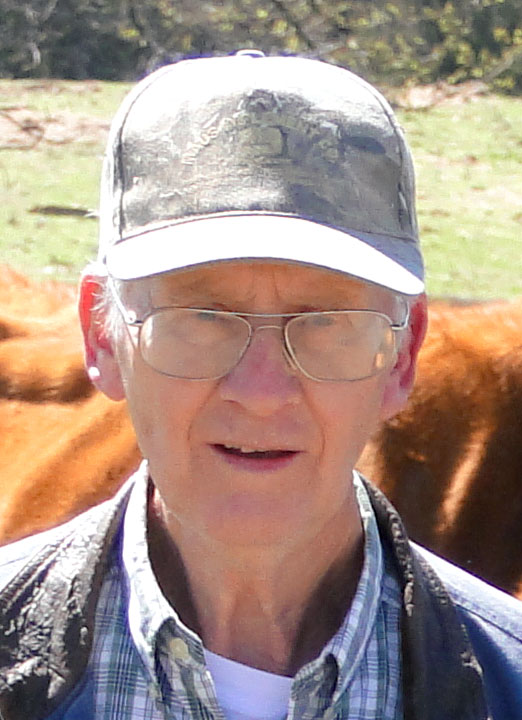
When 68-year-old Hartsel Hankins of Dover, Ark., was a tyke, he used to follow his dairyman grandfather, Chester Higgs, everywhere, helping with chores and watching him milk or plow with horses.
Hartsel’s parents delighted in telling the story of him coming home from his grandfather’s, getting a bucket and pretending to milk the draperies. Now Hartsel has two grandsons of his own, 8-year-old Gabriel and 6-year-old Wyatt.
“No matter what was going on at school or home, I could go to my grandfather’s where everything was always all right and fun.” Hartsel said. “Now I am doing the same for my grandsons but with chickens and commercial beef rather than dairy.”
Gabriel proved Hartsel’s success when he snuggled next to his grandfather during the interview with Ozarks Farm & Neighbor.
“I like showing chickens and working with my grandpa whatever he is doing,” he said.
Hartsel served in the Army during the Vietnam Era while his uncle, D.W. Trogli, maintained his half-dozen Milking Shorthorns until his return.
When he returned, Hartsel met his future wife Macil, who was still in high school and a basketball player.
Because of the premium for butterfat, the couple milked a primarily Jersey herd for four years.
“Dairying is the hardest farming job there is because it means milking twice a day every day of the year, but it was what I knew best and I liked it,” Hartsel said. “Nonetheless, four years later closing made the most sense because the government was decreasing the milk supply and his income declined to an unsatisfactory level. Hartsel switched to a small commercial beef herd and worked for the US Forest Service until he was laid off during the Reagan Administration. Subsequently, he worked at Arkansas Tech’s dairy.
Hartsel remembers driving through the Dover area when he was a youngster and observing how beautiful it was, never dreaming he would one day own land there. Nonetheless, that is exactly what happened. He saw a picturesque 47 acres for sale and bought it, moving his cattle herd and erecting a breeding house for Tyson chickens in 1996.
“Breeding hens made the most sense for me because they don’t have to be brooded which means significantly less operational costs since propane is unnecessary,” Hartsel said. “Even though breeding hens and their eggs are more labor-intensive.”
Flocks stay for 45 weeks, with the interval between flocks being anywhere from two to six weeks. Another advantage of the egg laying house is that Hartsel has had to make only one significant modernization since he built it: adding baffle curtains that push tunnel ventilation lower to the ground. Hartsel has found Tyson to be a good company to work with.
“They are always available for technical assistance whenever I need and are dependable with timely income checks,” he said.
The farm’s water source is rural water, which Hartsel finds a relief since chickens use a lot of water and drought is always a worry.
Early on, Hartsel’s mentor, Eulis Standridge, explained that chickens and cows, like a hand and glove. That proved even more true when Hartsel got a brochure from his county Extension agent explaining how to mix chicken litter with hay, ground corn and minerals to produce a good quality feed he uses mostly with his calves during winter. The remaining litter fertilizes his land which is made up of his owned acreage and another 125 leased acres in addition to the 100 acres he hays on shares.
Hartsel only spot sprays for thistle and brush hogs where needed.
Years ago, Hartsel learned from farmers in Arkansas’s German settlements that chasing fads or giving in to the latest technology is not smart.
“It’s not what you take to the bank; it’s what you leave there,” he said. “By going with what is natural for the environment I save money and my cattle do well.”
Hartsel follows the same philosophy in terms of vaccinations. He explained that observation through the years has not shown him that the return on administering vaccinations is worth the time and money.
Hartsel runs a herd of 40 primarily Simental/Angus cross momma cows with two bulls: one Angus/Chianina and one Angus/Maine Anjou. He likes the Angus/Chianina cross because they show well at the fair.
“I’m want my grandsons to have that experience and get started on a herd in case they want to raise cattle as adults. If they don’t, they will have had great experience and education in the process,” Hartsel said.
This year Hartsel performed AI on some of his cows, choosing sires for low birth weight. He is beginning to move his herd from mostly red to black. Hartsel raises spring calves, which he ear tags and bands at birth, subsequently weaning on Oct 1. He sells his calves at 600 pounds, some to a neighbor for backgrounding and some at the sale barn.
“I was 48 years old when I finally got to begin my dream of full-time farming. For me chickens are a labor for income but my cows are a labor of love,” Hartsel said.







